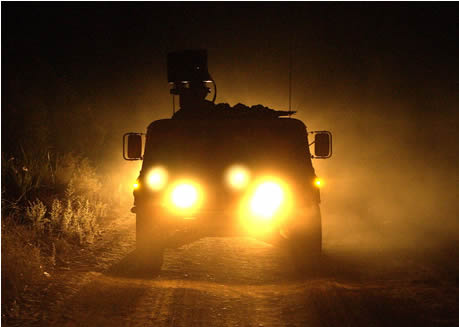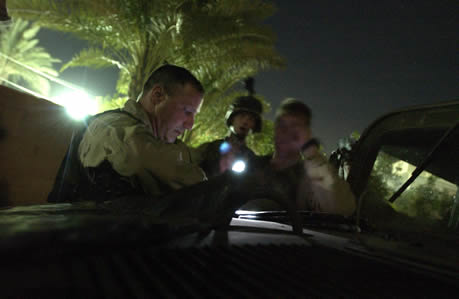|
|
| |||
|
USAREUR Public
Affairs | ||||
173rd Airborne on Peninsula Strike Story and photos by SFC Todd Oliver, SETAF Public Affairs
| ||||
The men and women of 2d Battalion, 503d
infantry, 173rd Airborne Brigade, are feeling the heat. One soldier’s watch, with a built
in temperature gauge, says it’s 134 degrees.
Who cares. 134, 130, 128 … with body armor
on, sitting in armored Humvees, they just become numbers. It’s just hot, hotter then
anything most people can imagine.
“It’s like turning on a hairdryer and holding it inches from your face,” remarks one paratrooper, sweating profusely.
Yes, it’s hot. Bottled water, if not cared for and tended to, quickly turns so hot as to make it impossible to drink. Almost impossible, that is. If you don’t drink out here, bad things can and do happen.
The paratroopers are unconcerned though. They handle the heat in a matter of fact manor. They all know they have to drink water, they know they have to be ready for anything and they know that there mission is just about to start.
While Kirkuk once seemed a boring,
tedious place to be stuck, far from the comforts of home and the arms of
loved ones they now view it with an almost loving affection.
Safe houses with air
conditioning units and refrigerators await their return.
For now though they sit and wait on an Iraqi Airfield, waiting for darkness. As the mid afternoon inferno slowly, almost begrudgingly, gives way to cooler night temperatures the paratroopers line up vehicles and prepare their attack.
As night falls and the earliest hours of morning creep in the vehicles roll out with a vengeance, kicking up the fine dirt power into an enormous cloud that covers everything, every crack and crevice, every inch of everything.
Everyone is hyper alert, everyone is ready, everyone is nervous. Everyone who has any brains is scared, if only just a little bit.
Tracer rounds fly low over rooftops and the sounds of automatic gunfire crack through the drone of the convoy. Then again as the fire is returned and again a third time is what can only be, well who knows what that can be.
Something’s happened, something up ahead, something to the convoy. Something’s happened.
Nothing stops. Everything keeps rolling, making
turns, zipping down streets, around obstacles, around corners and then
into the fight.
Or
rather, where the fight just was.
As the lead element, Able Company, continues to push towards its objective it drives through the site of the firefight that occurred seconds before. The bodies of paratroopers are on the ground, pulled close to barriers to afford them protection, being worked on by medics.
No one is sure if they are alive or dead. They are wounded, who knows how bad, there isn’t time to determine that. As soon as you see them, you’ve driven past them and on into the city. If this were a work of fiction, some paperback novel titled ‘men of guts and honor’ or ‘sacrifice city’ the rest would be a tale of fierce, bloody battles. But this isn’t that and the rest of the story, to borrow from Paul Harvey, works out a bit differently.
“The mission of 2-503d Inf (Abn) was a direct action, a direct attack on an assailant area known to have enemy actions,” said Lt. Col. Dominic Caraccilo, commander 2-503d Inf (Abn) toward the conclusion of the seven-day mission. “There have been a number of strikes in the last few weeks and the 4th Infantry Division commander decided to do some deliberate attacks in this particular area, surrounded by the tigress river, to destroy, detain or seize any high value targets that are suspected to be working in the area.”
 |
Now that it’s almost over and the paratroopers are preparing to move back to Kirkuk from this small Sunni enclave just north of Baghdad there is a sense of celebration in the air. Chickens, purchased at a local market through the interpreters, are grilling in the backyard of a temporary safe house alongside the Tigress river as the brutal sun finally starts to set. Sodas are being iced down and more then a few hands of spades are dealt. Caraccilo himself is in a good mood and occasionally tackles one of his staff officers between cigars and hands of spades, played with his sergeant major, his executive officer and his S3. The colonel and his sergeant major win, in case you keep track of that sort of thing.
Besides the search for and capture of high-ranking Ba’ath party officials the operation was also meant to show a strong U.S. presence in an area that, until recently, had been the site of one U.S. death per day on average, Caraccilo explains, taking a break from the din of the radios that constantly chatter. Even mid hand in a game of spades he runs into the house several times to monitor this patrol or that checkpoint.
No soldiers assigned to the Rock, as the 2-503d Inf (Abn) is known, were killed. Four soldiers were wounded, none seriously, when their vehicles drove through an ambush that erupted only seconds earlier. A fifth soldier was also injured when he fell from a rooftop during the operation.
“We also wanted to show a U.S. presence in an area that has yet to be covered by a U.S. force,” Caraccilo said. “Forces have driven over this area but no U.S. personnel have driven or patrolled or conducted any kind of military operation inside this particular peninsula.”
“The intent was to come here and go after some specific individuals, knowing perfectly well that most of the time when something like this is based off of human sources that the chances are your target wont be there when you arrive, none the less there has been a lot of action here so we know there are some unsavory figures. We had to screen more then 400 detainees in just the first two nights,” he explained.
And the screening paid off.
More then 50 of those 300 have been confirmed as Feydayeen, Caraccilo explained. “That’s a big deal. These people that we’re looking for are still husbanding the old regime as a way of life. By removing a pocket of Feydayeen soldiers we’ve done a pretty big thing.”
While no one was willing to call the locals here friendly there was a change in their demeanor over the course of the mission. While The 173d comes in full force they are quick to change tact’s, talking to leaders, talking to merchants and explaining why they are there, listening to concerns and generally trying to make everyone feel more at ease.
“I really do think that there are some unfriendly people here that don’t like Americans but I think you would find that anywhere in Iraq or even any part of the world,” he said. “But I think that mostly in this area the people are just confused. Confused and scared. When you come in here with 8 large helicopters, a battalion of Bradley fighting vehicles and a bunch of paratroops to swarm the area you scare some people. You hit them hard but then you pull back and you go out and you start talking to them and you tell them what you’re there for.”
And the colonel isn’t above doing some of that talking.
“I sat yesterday having tea with some of the people here. We were driving by and they waved at us and invited us inside for tea. We just talked to them. We described what it was we were doing and why. Come to find out two of the individuals had just gotten out of (an American) jail in Tikrit. Where else in the world can you sit with people you just detained for questioning and drink tea?” he said laughing.
It’s a struggle to understand the culture. I think we’re starting to figure it out. Once you understand the conditions, the right and left limit, I think you can get a lot accomplished.”


